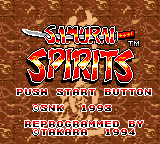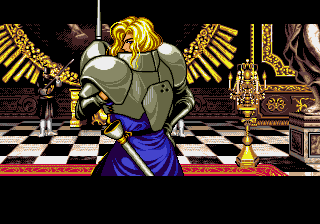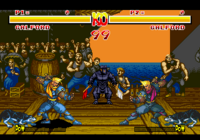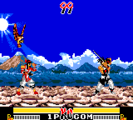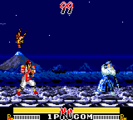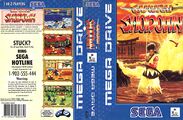Samurai Shodown
From Sega Retro
| Samurai Shodown | |||||||||||||||||||||||||||||||||||||||||||||||||||||||||||||||||||||||||||
|---|---|---|---|---|---|---|---|---|---|---|---|---|---|---|---|---|---|---|---|---|---|---|---|---|---|---|---|---|---|---|---|---|---|---|---|---|---|---|---|---|---|---|---|---|---|---|---|---|---|---|---|---|---|---|---|---|---|---|---|---|---|---|---|---|---|---|---|---|---|---|---|---|---|---|---|
| System(s): Sega Mega Drive, Sega Mega-CD, Sega Game Gear | |||||||||||||||||||||||||||||||||||||||||||||||||||||||||||||||||||||||||||
| Publisher: Sega Takara JVC Musical Industries | |||||||||||||||||||||||||||||||||||||||||||||||||||||||||||||||||||||||||||
| Developer: Saurus System Vision Funcom Santos | |||||||||||||||||||||||||||||||||||||||||||||||||||||||||||||||||||||||||||
| Distributor: Ecofilmes (PT) Sega-Ozisoft (AU) Tec Toy (BR) | |||||||||||||||||||||||||||||||||||||||||||||||||||||||||||||||||||||||||||
| Licensor: SNK | |||||||||||||||||||||||||||||||||||||||||||||||||||||||||||||||||||||||||||
| Original system(s): Neo Geo | |||||||||||||||||||||||||||||||||||||||||||||||||||||||||||||||||||||||||||
| Developer(s) of original games: SNK | |||||||||||||||||||||||||||||||||||||||||||||||||||||||||||||||||||||||||||
| Sound driver: SMPS 68000GEMS (sound effects) | |||||||||||||||||||||||||||||||||||||||||||||||||||||||||||||||||||||||||||
| Peripherals supported: Six Button Control Pad | |||||||||||||||||||||||||||||||||||||||||||||||||||||||||||||||||||||||||||
| Genre: Action[1][2][3][4] | |||||||||||||||||||||||||||||||||||||||||||||||||||||||||||||||||||||||||||
| Number of players: 1-2, 1 | |||||||||||||||||||||||||||||||||||||||||||||||||||||||||||||||||||||||||||
| Official in-game languages: | |||||||||||||||||||||||||||||||||||||||||||||||||||||||||||||||||||||||||||
| |||||||||||||||||||||||||||||||||||||||||||||||||||||||||||||||||||||||||||
|
Samurai Shodown, known as Samurai Spirits (サムライスピリッツ) in Japan, is a versus fighting game by SNK, originally released for the Neo Geo in 1993 and subsequently ported to a variety of platforms, including the Sega Mega Drive, Sega Mega-CD, and Sega Game Gear.
It is the first game in the Samurai Shodown series. It is one of the first fighting games with a focus on weapons rather than solely hand-to-hand combat.
Contents
Story
Shiro Tokisada Amakusa, slain in Japan in the 17th century by the forces of the Tokugawa Shogunate for his part in the Shimabara Rebellion, is resurrected over a hundred years later by the dark god Ambrosia. Driven by his hatred for the Shogunate, he unleashes his dark powers to rain destruction upon the world. A group of warriors converge upon the source of the chaos, each driven by their own motivations. The game takes artistic license to include foreign-born characters (including some from places that did not exist as such at the time), historical figures, and fictional monsters.
Gameplay
Mega Drive and Mega-CD versions
The game is a versus fighting game set in Japan in the late 18th century. All of the characters wield weapons. Compared to other fighting games, its gameplay is focused more on quick, powerful strikes than on combos. The goal is to win the best of three duels against an opponent. Each duel is timed. The winner is the player who depletes the other character's life meter or has the most life remaining when time runs out. In the Mega Drive version, a referee named Kuroko appears during the match and holds flags representing each player. The referee raises a flag whenever a player lands a successful hit.
Characters move with ![]() or
or ![]() . They backstep or dash with
. They backstep or dash with ![]()
![]() or
or ![]()
![]() . They jump upward with
. They jump upward with ![]() and jump behind and ahead with
and jump behind and ahead with ![]() or
or ![]() . They crouch with
. They crouch with ![]() . Using a Six Button Control Pad, characters can slash (or punch if disarmed) with
. Using a Six Button Control Pad, characters can slash (or punch if disarmed) with ![]() (weak),
(weak), ![]() (normal), or
(normal), or ![]() (strong) and kick with
(strong) and kick with ![]() (weak),
(weak), ![]() (normal), or
(normal), or ![]() (strong). Powerful strikes are accompanied by a slow-motion effect to intensify the hit.
(strong). Powerful strikes are accompanied by a slow-motion effect to intensify the hit.
Using a standard control pad on the Mega Drive version, characters slash or punch with ![]() (weak),
(weak), ![]() (normal), or
(normal), or ![]() (strong) and kick with
(strong) and kick with ![]() +
+![]() (weak),
(weak), ![]() +
+![]() (normal), or
(normal), or ![]() +
+![]() (strong). On the Mega-CD version, characters slash or punch with
(strong). On the Mega-CD version, characters slash or punch with ![]() (weak),
(weak), ![]() (normal), or
(normal), or ![]() +
+![]() (strong) and kick with
(strong) and kick with ![]() (weak),
(weak), ![]() +
+![]() (normal), or
(normal), or ![]() +
+![]() (strong).
(strong).
When characters slash each other at the same time, they lock swords. Players must press the slash buttons rapidly to break the lock, with the player who loses the hold (by not pressing the buttons as fast as the opposing player) having the character knocked back and disarmed. A character can equip his or her weapon again by pressing a slash button while standing next to it. Weapons are weakened each time they hit each other; it is possible for a weapon to break, in which case it is unavailable for the rest of the duel. In addition to their standard attacks, characters can perform special moves using specific button combinations (though many special moves cannot be performed if the character is disarmed).
Guarding is done by holding the D-Pad away from the opponent. Guarding can be done while standing or crouching. Most attacks can be blocked while standing or crouching, but some attacks must specifically be blocked high or low. Characters can become dizzy and stunned momentarily after taking repeated damage; they can recover more quickly by moving the D-Pad and pressing buttons rapidly. Characters can throw an opponent by holding ![]() or
or ![]() while pressing the medium or strong slash or kick button in close range. Throws cannot be blocked. Each character has a POW meter (also called a "Rage gauge") that fills as the player is hit by enemy attacks or guards against an attack. When the meter is full, the character turns red and attacks with increased strength for a duration.
while pressing the medium or strong slash or kick button in close range. Throws cannot be blocked. Each character has a POW meter (also called a "Rage gauge") that fills as the player is hit by enemy attacks or guards against an attack. When the meter is full, the character turns red and attacks with increased strength for a duration.
Modes
In the single-player mode, the player faces every character in a randomized order, ending in a fight against the boss Amakusa. The game ends if the player loses a match. The Mega Drive version has unlimited continues, but the Mega-CD version only allows the player to continue up to three times. A bonus stage appears after every three matches where the character destroys straw dummies that pop up in three randomized positions for extra points. A second player can join the game as an opponent by pressing START at any time. The Mega Drive version has eight difficulty levels (but the ending for the character is only shown if playing on 4 or above). The Mega-CD version has four difficulty levels (Easy, Normal, Hard, and a "Vs Mode" difficulty that is between Normal and Hard and equivalent to the arcade version).
The Mega Drive version has a dedicated two-player mode where players can choose a handicap and a stage. The Mega-CD version only allows two-player matches in the standard arcade mode (with players able to choose different characters at the end of every match without returning to the character select screen, to mitigate load times). The Mega Drive version has an additional two-player "Showdown" mode where each player chooses five characters to fight in five consecutive matches.
Items
In the Mega Drive version, a courier named Hikyaku sometimes runs by in the background to throw items into the stage. There is an option to disable items or change the frequency that they appear. In the Mega-CD version, there is no courier, but items sometimes fall from the top of the screen instead.
| Meat | |
|---|---|
| Restores partial vitality for a character when walked over. | |
| Coins | |
| Awards bonus points when walked over. | |
| Bomb | |
| Explodes and damages either fighter if nearby. This item is not present in the Mega-CD version. |
Characters
Note: Move lists assume that the character is facing right. When facing left, ![]() and
and ![]() should be reversed.
should be reversed.
| S | Any slash button |
| LS | Light slash |
| MS | Medium slash |
| HS | Hard slash |
| K | Any kick button |
| LK | Light kick |
| MK | Medium kick |
| HK | Hard kick |
Playable
All of the characters from the Neo Geo game are present except for Earthquake.
| Charlotte | |
|---|---|
|
Birthplace: France Age: 27 Weapon: Laroche | |
| Charlotte is a French noblewoman and master fencer. | |
| Galford | |
|
Birthplace: San Francisco, U.S.A. Age: 39 Weapon: Blade of Justice | |
| Galford is an American who traveled to Japan to become a ninja. He is aided by his pet dog, Poppy. | |
| Gen-An | |
|
Birthplace: Oninakijima, Japan Age: 26 Weapon: Azami (named after his wife) | |
| Gen-An is a monstrous creature with clawed hands. He is a member of the enigmatic Shiranui clan (a reference to Mai Shiranui from the Fatal Fury games). | |
| Hanzo | |
|
Birthplace: Dewasanchu, Japan Age: 34 Weapon: Unnamed (ninja-style sword) | |
| Hanzo is an Iga ninja who fights to save his son from Amakusa's control. He is based on the historical figure Hittori Hanzou, like the character of the same name from the World Heroes games. | |
| Haohmaru | |
|
Birthplace: Musashinokuni, Japan Age: 25 Weapon: The Fugu Blade | |
| Haohmaru is a wandering samurai who is searching for strong opponents to hone his skills. | |
| Jubei | |
|
Birthplace: Tosa, Japan Age: 39 Weapon: The Tokugawa Defender and the Iron Tiger Saber | |
| Jubei is a ronin who strives to protect Japan from its enemies. | |
| Kyoshiro | |
|
Birthplace: Edo (Old Tokyo) Age: 30 Weapon: Kabuki Slasher | |
| Kyoshiro is a kabuki performer who uses his art to entertain and perfect his own fighting skills. | |
| Nakoruru | |
|
Birthplace: Ainumoshiri Kamuikotan, Japan Age: 17 Weapon: Nature's Wrath | |
| Nakoruru is a young girl who strives to protect nature. She is aided by her pet hawk, Mamahaha. | |
| Tam Tam | |
|
Birthplace: Greenvale, Ixlpalotal Age: 19 Weapon: Hengei-Hangei-Zangei | |
| Tam Tam is an Incan warrior who is charged with retrieving the stolen Palenke Stone back from Amakusa. | |
| Ukyo | |
|
Birthplace: Kogagunmasugimura, Omi, Japan Age: 24 Weapon: Unnamed (made by Tachibana himself) | |
| Ukyo is an ailing samurai warrior who is fighting to gain a flower for his beloved. | |
| Wan-Fu | |
|
Birthplace: China (descendant of a royal line) Age: 35 Weapon: Sword of the Emperor | |
| Wan-Fu is a Chinese warrior who serves the Qing Emperor. He searches Japan for worthy fighters to help him unify his homeland. |
Bosses
In the Mega Drive version, Amakusa is playable in the two-player modes. In the Mega-CD version, he is not playable.
| Amakusa | |
|---|---|
| Amakusa is a powerful sorcerer, resurrected by the dark god Ambrosia. He carries a mystical artifact known as the Palenke Stone. He is based on the historical figure Amakusa Shirou. He is the final boss of the game. He is playable in two-player matches in the Mega Drive version. |
Stages
- Main article: Samurai Shodown/Comparisons.
Each character has his or her own stage where battles are hosted.
Game Gear version
The game is a fighting game. Compared to the other versions of the game, it has simplified controls and omits some of the characters and special moves. There is a single-player mode where the player chooses a character and fights every other character in random order, ending with the final boss Amakusa. There is no two-player mode.
Characters move with ![]() or
or ![]() . They backstep or dash with
. They backstep or dash with ![]()
![]() or
or ![]()
![]() . They jump upward with
. They jump upward with ![]() and jump behind and ahead with
and jump behind and ahead with ![]() or
or ![]() . They crouch with
. They crouch with ![]() . Characters can slash (or punch if disarmed) with
. Characters can slash (or punch if disarmed) with ![]() and kick with
and kick with ![]() . Slashes and kicks only have one strength, but characters can perform a "power slash" with
. Slashes and kicks only have one strength, but characters can perform a "power slash" with ![]() +
+![]() , which is a slower but stronger attack.
, which is a slower but stronger attack.
Characters lock swords when they slash each other at the same time. The player must press ![]() rapidly to break the hold. If the player presses the button fast enough, the opponent is thrown back and disarmed; otherwise, the player's character is. Weapons are re-equipped by standing over them and pressing
rapidly to break the hold. If the player presses the button fast enough, the opponent is thrown back and disarmed; otherwise, the player's character is. Weapons are re-equipped by standing over them and pressing ![]() . Characters can perform special moves using specific button combinations (though some moves require a weapon to perform).
. Characters can perform special moves using specific button combinations (though some moves require a weapon to perform).
Guarding is done by holding the D-Pad away from the opponent. Guarding can be done while standing or crouching. Most attacks can be blocked while standing or crouching, but some attacks must specifically be blocked high or low. Characters can become dizzy and stunned momentarily after taking repeated damage; they can recover more quickly by moving the D-Pad and pressing buttons rapidly. Characters can throw an opponent by holding ![]() or
or ![]() while pressing the slash or kick button in close range. Throws cannot be blocked. Each character has a POW meter (also called a "Rage gauge") that fills as the player is hit by enemy attacks or guards against an attack. When the meter is full, the character turns red and attacks with increased strength for a duration.
while pressing the slash or kick button in close range. Throws cannot be blocked. Each character has a POW meter (also called a "Rage gauge") that fills as the player is hit by enemy attacks or guards against an attack. When the meter is full, the character turns red and attacks with increased strength for a duration.
Items
Items sometimes fall from the top of the screen during a match.
| Meat | |
|---|---|
| Restores partial vitality for a character when walked over. | |
| Bomb | |
| Explodes and damages either fighter if nearby. |
Characters
All of the characters from the Neo Geo game are present except for Earthquake, Tam Tam, and Wan-Fu. Amakusa is the final boss and can be unlocked to play by completing the game with any character or by using a cheat code.
- Charlotte
- Galford
- Gen-An
- Hanzo
- Haohmaru
- Jubei
- Kyoshiro
- Nakoruru
- Ukyo
- Amakusa
Stages
Each character has his or her own stage where battles are hosted.
Versions
The Mega Drive and Mega-CD versions were ported separately and by different companies. Both lack the character Earthquake, likely due to the large size of his sprite, and omit the zooming effect from the original Neo Geo versions, instead employing a fixed perspective. The fatal finishing attacks, where the opponent is sliced in half, are also omitted, but the blood is retained. The Mega Drive version includes the referee in the background of every fight, and the final boss Amakusa is playable in two-player matches. The Mega Drive version is missing the arcade introduction, the character artwork shown after a match, and many of the announcer lines. The Mega-CD version restores these omissions and also reproduces the arcade soundtrack, but the referee is absent and Amakusa is not playable in this version.
The Neo Geo versions use a four-button layout, where strong attacks are performed by pressing the weak and normal punch or kick buttons simultaneously. The Mega Drive and Mega-CD versions allow for a six-button layout where each strength is assigned its own button (similar to Capcom's fighting games).
The Super NES port includes Earthquake but has smaller sprites than the Mega Drive and Mega-CD versions. It likewise omits the fatal finishing moves and also replaces the blood with "sweat." Amakusa is playable in two-player matches with a cheat code.
The 3DO port is the only contemporaneous port of the game to retain the camera zooming and all of the violence from the Neo Geo versions.
Localised names
| Language | Localised Name | English Translation |
|---|---|---|
| English | Samurai Shodown | Samurai Shodown |
| English (US) | Samurai Shodown | Samurai Shodown |
| Japanese | サムライスピリッツ | Samurai Spirits |
Production credits
Mega Drive version
- Executive Producer: Nobuyuki Tanaka
- Producer: Yasushi Okahara, Takahiro Shima
- Direction: Zizi
- Main Programmer: Haccyan
- Assistant Programmer: Yama
- Graphic System: Hideki
- Graphic Design: Original from SNK
- Graphic Design Modify: M.Toshiro, T.Koyama
- Sound Design: Original from SNK
- Sound System: Den
- Sound Arrangement: Shinichi Yamazaki, Kazuhiko Oshikiri, Hideki Nagai, Hiroyuki Takei
- Collision Tuning: Kuzira, Shikanosuke, Koyaman 3D
- Producers: S.Suzuki
- Director: T.Ikenoue
- Production Composers: T.Hocho, K.Kijima, S.Takagi, D.Fowler
- USA Marketing Planner: T.Kinya
- Art Work Composers: INTAC I.T.C. Staff
- Special Thanks to: All SNK Staff, Rika
- Translated by: Saurus Co., Ltd.
- Presented by: Takara Co., Ltd.
Mega-CD version
- Executive Producer: Makato Orii
- Producer: Yoji Takenaka
- Game Testers: Aki Akaike, Julio C Arreygue, Jeremy Klein
- Executive Producer: Harunobu Komori
- Producer: Toshiyuki Nagai
- Director: Kazuya Tominaga
- Co Director: Gaku Sato
- Assistant: Ryo Misawa
- Main Programmer: Roar Flølo
- Cruncher and Realtime Animation Decruncher: Eivind Hagen, Johan Köhler, Morten B Ofstad
- Other Programming: Anders Dybdahl, Eivind Eklund, Morten B Ofstad, Carl-Henrik Skårstedt
- Graphic Artists: Joachim Barrum, Torkell Bernsen, Colin McMahon, Tommy Svensson
- Music and Sound: Kim Jensen
- Animation Editing: Vebjørn Strømmen
- Producer: Trond W Larsen
Magazine articles
- Main article: Samurai Shodown/Magazine articles.
Promotional material
- Main article: Samurai Shodown/Promotional material.
Artwork
Physical scans
Mega Drive version
| Sega Retro Average | |||||||||||||||||||||||||||||||||||||||||||||||||||||||||||||||||||||||||||||||||||||||||||||||||||||||||||||||||||||||||||||||||||||||||||||||||||||||||||||||
|---|---|---|---|---|---|---|---|---|---|---|---|---|---|---|---|---|---|---|---|---|---|---|---|---|---|---|---|---|---|---|---|---|---|---|---|---|---|---|---|---|---|---|---|---|---|---|---|---|---|---|---|---|---|---|---|---|---|---|---|---|---|---|---|---|---|---|---|---|---|---|---|---|---|---|---|---|---|---|---|---|---|---|---|---|---|---|---|---|---|---|---|---|---|---|---|---|---|---|---|---|---|---|---|---|---|---|---|---|---|---|---|---|---|---|---|---|---|---|---|---|---|---|---|---|---|---|---|---|---|---|---|---|---|---|---|---|---|---|---|---|---|---|---|---|---|---|---|---|---|---|---|---|---|---|---|---|---|---|---|
|
| 76 | |
|---|---|
| Based on 31 reviews | |
Mega-CD version
| Sega Retro Average | |||||||||||||||||||||||||||||||||||||||||||||||||||||||||||||||||||||||||||||||
|---|---|---|---|---|---|---|---|---|---|---|---|---|---|---|---|---|---|---|---|---|---|---|---|---|---|---|---|---|---|---|---|---|---|---|---|---|---|---|---|---|---|---|---|---|---|---|---|---|---|---|---|---|---|---|---|---|---|---|---|---|---|---|---|---|---|---|---|---|---|---|---|---|---|---|---|---|---|---|---|
|
| 71 | |
|---|---|
| Based on 15 reviews | |
| Mega-CD, AU |
|---|
|
Game Gear version
| Sega Retro Average | |||||||||||||||||||
|---|---|---|---|---|---|---|---|---|---|---|---|---|---|---|---|---|---|---|---|
|
| 65 | |
|---|---|
| Based on 3 reviews | |
Technical information
- Main article: Samurai Shodown/Technical information.
ROM dump status
| System | Hash | Size | Build Date | Source | Comments | |||||||||
|---|---|---|---|---|---|---|---|---|---|---|---|---|---|---|
| ? |
|
512kB | Cartridge (US) | |||||||||||
| ? |
|
512kB | Cartridge (JP) |
References
- ↑ File:SamuraiShodown MD JP Box.jpg
- ↑ 2.0 2.1 https://sega.jp/history/hard/megadrive/software.html (Wayback Machine: 2020-07-20 09:51)
- ↑ File:SamuraiShodown GG JP Box Front.jpg
- ↑ 4.0 4.1 http://sega.jp/fb/segahard/gg/soft_licensee.html (Wayback Machine: 2013-01-01 20:24)
- ↑ Mega Play, "August 1994" (US; 1994-0x-xx), page 40
- ↑ 6.0 6.1 6.2 6.3 Sega Magazine, "February 1995" (UK; 1995-01-15), page 94
- ↑ 7.0 7.1 Games World: The Magazine, "April 1995" (UK; 1995-0x-xx), page 13
- ↑ 8.0 8.1 File:NewReleasesCatalogueApril-May1995AU.pdf, page 12
- ↑ https://groups.google.com/g/rec.games.video.sega/c/2_XPmLVygEY/m/2fcTyybkMLsJ
- ↑ 10.0 10.1 Computer & Video Games, "July 1995" (UK; 1995-06-09), page 60
- ↑ 11.0 11.1 Sega Power, "July 1995" (UK; 1995-05-18), page 52
- ↑ Computer Trade Weekly, "" (UK; 1995-08-14), page 16
- ↑ File:SegaPower 68 jul 95.pdf, page 52
- ↑ File:Samurai Shodown MD credits.pdf
- ↑ File:Samurai Shodown MCD credits.pdf
- ↑ GamesMaster, "March 1995" (UK; 1995-02-16), page 72
- ↑ 1700 igr dlya Sega, "" (RU; 2001-xx-xx), page 198
- ↑ Beep! MegaDrive, "December 1994" (JP; 1994-11-08), page 23
- ↑ Consoles +, "Janvier 1995" (FR; 199x-xx-xx), page 110
- ↑ Cool Gamer, "9" (RU; 2002-10-13), page 180
- ↑ Digitiser (UK) (1995-04-12)
- ↑ Electronic Gaming Monthly, "November 1994" (US; 1994-xx-xx), page 46
- ↑ Famitsu, "1994-11-25" (JP; 1994-11-11), page 40
- ↑ Freak, "1/95" (IL; 1995-xx-xx), page 1
- ↑ GamePro, "December 1994" (US; 1994-xx-xx), page 44
- ↑ Hobby Consolas, "Marzo 1995" (ES; 1995-xx-xx), page 60
- ↑ Joypad, "Mars 1995" (FR; 1995-0x-xx), page 88
- ↑ MAN!AC, "03/95" (DE; 1995-02-08), page 61
- ↑ Mega, "May 1995" (UK; 1995-04-30), page 16
- ↑ Mega Fun, "02/95" (DE; 1995-01-18), page 96
- ↑ Micro Kid's Multimédia, "Mai 1995" (FR; 1995-0x-xx), page 62
- ↑ Micromanía (tercera época), "Febrero 1995" (ES; 1995-xx-xx), page 106
- ↑ Mean Machines Sega, "March 1995" (UK; 1995-01-30), page 76
- ↑ Next Generation, "Premiere Issue 1995" (US; 1994-12-08), page 108
- ↑ Player One, "Mars 1995" (FR; 1995-0x-xx), page 82
- ↑ Play Time, "3/95" (DE; 1995-02-08), page 110
- ↑ Saturn Fan, "1995 February" (JP; 1995-01-07), page 33
- ↑ Sega Power, "March 1995" (UK; 1995-01-19), page 40
- ↑ Sega Pro, "February 1995" (UK; 1994-12-29), page 34
- ↑ Sega Mega Drive Review, "2" (RU; 1996-01-03), page 115
- ↑ Sega Saturn Magazine, "September 1995" (JP; 1995-08-08), page 86
- ↑ Todo Sega, "Marzo 1995" (ES; 1995-0x-xx), page 30
- ↑ Tricks 16 bit, "Tricks Sega Gold 800 igr" (RU; 1998-03-20), page 151
- ↑ Video Games, "3/95" (DE; 1995-02-23), page 91
- ↑ VideoGames, "December 1994" (US; 1994-1x-xx), page 101
- ↑ Electronic Gaming Monthly, "June 1995" (US; 1995-0x-xx), page 36
- ↑ Electronic Gaming Monthly, "August 1995" (US; 1995-0x-xx), page 36
- ↑ GamePro, "September 1995" (US; 1995-xx-xx), page 48
- ↑ Gamers, "November 1995" (DE; 1995-10-11), page 55
- ↑ Game Informer, "June 1995" (US; 1995-0x-xx), page 54
- ↑ Hobby Consolas, "Agosto 1995" (ES; 1995-xx-xx), page 78
- ↑ Mega, "September 1995" (UK; 1995-08-31), page 20
- ↑ Player One, "Novembre 1995" (FR; 1995-1x-xx), page 142
- ↑ Sega Magazin, "Februar 1996" (DE; 1996-01-10), page 10
- ↑ Sega Magazine, "July 1995" (UK; 1995-06-15), page 82
- ↑ Sega Pro, "August 1995" (UK; 1995-07-13), page 65
- ↑ Videogame Advisor, "Volume 1, Number 3: July 1995" (US; 1995-0x-xx), page 32
- ↑ VideoGames, "September 1995" (US; 1995-08-22), page 81
- ↑ Beep! MegaDrive, "January 1995" (JP; 1994-12-08), page 27
- ↑ Famitsu, "1994-12-23" (JP; 1994-12-09), page 44
- ↑ Sega Saturn Magazine, "September 1995" (JP; 1995-08-08), page 88
| Samurai Shodown | |
|---|---|
|
Main page | Comparisons | Hidden content | Bugs | Magazine articles | Video coverage | Reception | Promotional material | Region coding | Technical information | Bootlegs
Demos: Samurai Shodown (1995) | |
| Samurai Shodown/Samurai Spirits games for Sega systems | |
|---|---|
| Samurai Shodown (1994) | |
| Samurai Shodown (1994) | |
| Samurai Shodown (1995) | |
| Samurai Spirits Zankurou Musouken (1996) | Shinsetsu Samurai Spirits Bushidou Retsuden (1997) | Samurai Spirits Amakusa Kourin (1997) | Samurai Spirits Best Collection (1998) | |
| Nakoruru: Anohito Kara no Okurimono (2002) | |
| Samurai Spirits Tenkaichi Kenkakuden (2005) | |
| Unlicensed Samurai Shodown/Samurai Spirits games for Sega systems | |
| Soul Edge vs. Samurai Spirits (1997) | Shin Samurai Spirits Haohmaru Jigokuhen (1998) | |
- Six Button Control Pad-compatible games
- 1-2 player games
- JP Mega Drive games
- All JP games
- US Mega Drive games
- All US games
- EU Mega Drive games
- All EU games
- PT Mega Drive games
- All PT games
- UK Mega Drive games
- All UK games
- AU Mega Drive games
- All AU games
- Mega Drive games
- 1994 Mega Drive games
- All 1994 games
- Mega Drive action games
- All action games
- JP Game Gear games
- US Game Gear games
- Game Gear games
- 1994 Game Gear games
- Game Gear action games
- US Mega-CD games
- EU Mega-CD games
- PT Mega-CD games
- UK Mega-CD games
- AU Mega-CD games
- BR Mega-CD games
- All BR games
- Mega-CD games
- 1995 Mega-CD games
- All 1995 games
- Mega-CD action games
- All games
- Old-style rating (gamesmaster)
- Update ratings template
- 1 old ratings
- Old technical information
- Samurai Shodown
- Samurai Shodown (franchise)




